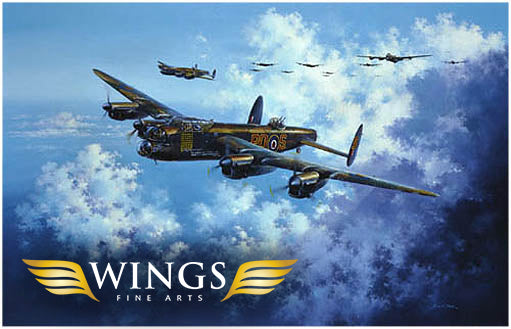Spitfires - High Patrol by Philip West - Aviation Art
- Variant: Limited Edition
- In Stock: 1
- Brand: Wings Fine Arts
- Collection: The Spitfire Fighter
Product Specs
Spitfires - High Patrol
by Philip West
A gathering section of 124 Squadron Spitfires led by Peter Ayerst climbs for height above the bomber stream and a lone Mosquito. This Squadron plus many others was tasked with protecting the bombers over occupied Europe. For these long range missions the Spitfires carry 90 Gallon 'Slipper Tanks' to extend the relatively short endurance of the aircraft. In combat with enemy fighters they would jettison the tanks. However, following a shortage, they were encouraged to bring them back if they possibly could.
The Signatures:
Wing Commander Peter Ayerst DFC. Few RAF pilots flew operationally from the beginning to the end of the Second World War. Fewer still can claim to have experienced action from Dunkirk and the Battle of Britain, El Alamein and the D-Day landings, to bomber escort duty in the closing days of the war in Europe. Peter Ayerst is one such man.
Peter joined the RAF in 1938 on a short service commission and was despatched to France when war broke out. After serving with legendary fighter ace Douglas Bader, Peter was posted to North Africa in 1942 where he was forced to crash-land his Hurricane in a minefield.
Peter flew Spitfires on intruder sorties over France before and during D-Day, on bomber escort duty against V-weapons sites and in support of mass daylight raids deep into Germany. Awarded the DFC in December 1944, he also flew as fighter escort to King George VI's Dakota. By the war's end, Peter had flown every mark of Spitfire and Hurricane in the RAF's inventory! This stood him in good stead after the war when he worked with famous test pilot Alex Henshaw: he was part of the flight-test crew when Henshaw rolled a Lancaster.
Flight Lieutenant R G (Bob) Large, DFC, Legion d’Honneur, learned to fly in Scotland in 1940 and in 1941 joined 616 Squadron as part of the Tangmere Wing, commanded by the famous legless pilot Wing Commander Douglas Bader. The Squadron flew Fighter and Bomber sweeps over Northern France. The remains of Bob’s Spitfire lie at the bottom of the sea ten miles off Hythe (where he now lives) after being bounced by eighty plus ME 109Gs over the English Channel.
Having learned of the activities of 161 SD Squadron he was interviewed by the CO, Wing Commander Lewis Hodges, and joined the Lysander Flight. He then flew many important missions into occupied France in single, double and a memorable treble pickup when his excuse for being late at the rendezvous was that he had had a haircut “in the firm’s time” because “it grew in the firm’s time”! After D-Day he returned to Fighter Command and later flew Meteors. (Bob’s dog, Patrick, became the first dog in the Allied Forces to fly in a jet which took place in a Meteor 3 on 11th May 1946 and is now recorded in the Guinness Book of Records!








